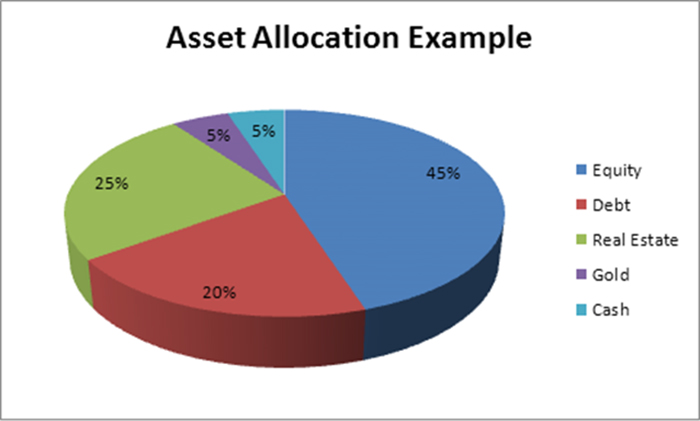6 MinsFeb 3, 2022
Investing is an individualistic exercise. Simply following what your relatives, friends, colleagues, next-door neighbours, do with their investments is not the best approach.
Hence before you invest, ask yourself the following questions:
- What are my investment objectives?
- Which are the financial goals I wish to address?
- Can I afford to take the risk?
- How much time do I have before the financial goals come to fruition?
What is asset allocation?
Asset Allocation refers to distributing your investible surplus across asset classes such as equity, debt, gold, real estate or even holding cash. The focus is to balance/reduce risk through optimal diversification of the overall portfolio. Thus,
asset allocation is the cornerstone of investing and is essential to ensure that you reach your financial goals in the right fashion.

Every asset class –– equity, debt, gold and real estate –– has a distinctive risk-return trade-off suitable for certain types of investors.
Traits of asset classes
| Equity | Real Estate | Gold | Debt |
|---|
| Return | High [Capital Appreciation over long term & Dividend Income] | High [Capital Appreciation over the long term, and if let out, Rental Income] | Moderate-to-High [Capital Appreciation over long term] | Low [Interest Income from Bank FDs; Capital Appreciation in case of Debt MFs] |
| Indicative Risk | High | High | Moderate | Moderate to Low |
| Liquidity | High | Low | High | Medium |
| Indicative Suitability | For long-term investors having a high-risk appetite | For long-term investors having a high-risk appetite | For all investors as a tactical allocation -- but to be held preferably with a longer investment horizon | For short-term Investors having a low-risk appetite |
| Investment Avenues Available | Equity-oriented mutual funds; direct equity | Residential Property; Commercial Property; Real estate funds; Real Estate Investment Trusts (REITS) | Physical gold (bars, coins, jewellery, etc.); Gold ETFs; Gold Savings Fund; Sovereign Gold Bond Scheme, Digital Gold
| Bank FD; Small Savings Scheme; Debt Mutual Funds; Money Market Mutual Funds; Direct Bonds (Non-Convertible
Debentures, etc.) |
(For illustrative purpose only)
Key factors that define asset allocation
1. Age – As a thumb rule, you may follow the “100 minus your current age” formula for high-risk investment avenues such as equities. For instance, if you are 30 years, going by the formula, 70% of your total
investments should be in equities, whereas the remaining 30% can be in debt or fixed-income investment instruments. To put it differently, the proportion of debt/ fixed-income investments should be equal to your age.
The rationale behind this is that usually, risk tolerance is high when you are young. But as age advances, you may not be able to tolerate high risk, or you may have responsibilities to shoulder, or you may be nearing your financial goals; hence
the asset allocation needs to be reviewed and reset.
When you are nearing retirement or retired, capital preservation should be your primary objective. Therefore, the allocation to debt or fixed-income instruments should be higher as compared to equities.
2. Income – Consider both current and future income when allocating your assets. If you are in the wealth accumulation phase of your life, with a high income and the possibility of your income rising, you do not mind taking
the risk and allocating a higher amount to equities. But if your income is not high or is fluctuating, you may not be willing to take the risk. So, how much you earn and how well you manage your expenses has a bearing on your investible surplus
and asset allocation.
3. Existing investments and assets – Before you make fresh investments, weigh your existing investments and allocation to the respective asset class. This will ensure that you do not end up investing more in one particular
asset class, while not investing enough in another. For instance, enthused by rising equity markets, you may invest a higher portion of your portfolio in equity investments. Or if you are conservative, you may invest a higher share in debt
or fixed income instruments, ignoring the impact of inflation. Neither of these is a prudent investment approach.
4. Debt and responsibilities – Many of you may have a loan or other financial responsibilities. These weigh on your risk-taking ability and the investible surplus (particularly if you are repaying a high-interest loan).
In such a case, allocating unreasonably to high-risk assets such as equities may not be wise. You need to maintain the right balance across asset classes and ensure that you are repaying the loans regularly on time.
Similarly, when you have financial responsibilities such as your child’s education and wedding expenses, or if you have dependent family members, it influences your risk-taking ability. Only when you have enough financial reserves or have
made provisions already, can you afford to take higher risk.
Also Read: [How long is ‘long term’ when it comes to equity investing?]
5. Time horizon-to-goal – If you are many years away from your financial goals, then you may allocate or hold a higher portion of your portfolio in high-risk assets such as equities. The longer time frame may permit you
to assume higher risk and earn potentially higher returns.
But if your goal is just a few years away -- say less than 3 years -- saving or protecting your wealth with safe avenues and not deploying in risky assets will be a sensible approach.
Asset allocation as per time horizon-to-goal
| Time Horizon | Equity | Debt | Gold |
|---|
| 0-3 years | 0% | 95% | 5% |
| 3-5 years | 40% | 50% | 10% |
| 5-8 years | 55% | 30% | 15% |
| 8-10 years | 60% | 25% | 15% |
| More than 10 years | 70% | 15% | 15% |
Note: The table is indicative and for illustrative purposes only
For example, if your child’s wedding is 20 years from now, it may be prudent to invest in equities -- directly in stocks (if you have an expertise to invest and review on a consistent basis) or via equity mutual funds. But as you approach
the goal, you should pay attention to preserving wealth.
Defining your asset allocation sensibly serves as an investment strategy in itself, acts as a shield, and attempts to balance risk-reward
Defining asset allocation is not a one-time exercise. Hence, determine your desired asset allocation to help you reach your financial goals, align your investments accordingly and periodically review and re-balance, to ensure that you are taking
adequate but not unnecessary risk to achieve your goals.
Disclaimer: This article has been authored by PersonalFN, a Mumbai based Financial Planning and Mutual Fund research firm. Axis Bank doesn't influence any views of the author in any way. Axis Bank & PersonalFN shall not be responsible for any direct / indirect loss or liability incurred by the reader for taking any financial decisions based on the contents and information. Please consult your financial advisor before making any financial decision.















